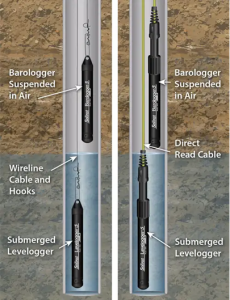 Deploying leveloggers for level, temp and conductivity monitoring involves choosing the right method based on your project needs. Here are three common deployment options along with their benefits:
Deploying leveloggers for level, temp and conductivity monitoring involves choosing the right method based on your project needs. Here are three common deployment options along with their benefits:
- Suspension Cable Deployment: This method involves using a standard suspension cable, such as the stainless-steel cable offered by HydroTerra. Cable comes in 1.6mm or 2.0mm diameters, cut to the required lengths with swages. While being a low-cost option, it does require manual retrieval of the leveloggers for data download. Stainless steel works well in most environments but may not be suitable for highly conductive environments prone to corrosion. In such cases, materials like kevlar or plastic lines with high corrosion resistance can be considered.
- Direct Read Cable Deployment: A more efficient approach is deploying leveloggers with a direct read cable. This method significantly saves retrieval time as data can be accessed from the well surface using various communication options like Bluetooth to personal devices, USB interfaces like the “Datagrabber,” or direct USB cable connection to a PC. The cables for the barologger and levelogger can fit neatly into the Solinst Well Cap, facilitating quick data retrieval without pulling the levelogger to the surface. This method ensures faster data retrieval and offers multiple data download options.
- Telemetry Integration: For real-time monitoring and enhanced data security, integrating leveloggers with telemetry options is ideal. HydroTerra offers various telemetry options based on site and project requirements, including cellular and satellite communication. Telemetry not only provides real-time data access without physically accessing the site but also notifies users of any issues promptly. Data security is enhanced as the data is logged on both the levelogger and securely stored in the cloud.
Choosing the best deployment method depends on factors such as site conditions, data retrieval frequency, budget, and the need for real-time monitoring. Consulting with our team can help determine the most suitable deployment option for your specific requirements.
Further information can be found here.





